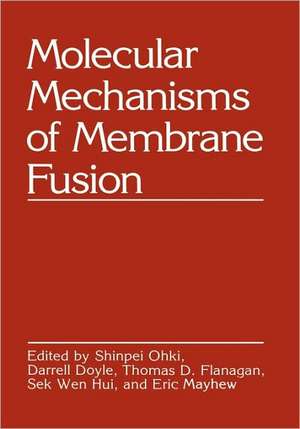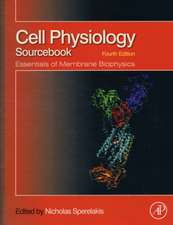Molecular Mechanisms of Membrane Fusion
Autor Shinpei Ohkien Limba Engleză Hardback – 31 mai 1988
| Toate formatele și edițiile | Preț | Express |
|---|---|---|
| Paperback (1) | 965.97 lei 6-8 săpt. | |
| Springer Us – 29 noi 2011 | 965.97 lei 6-8 săpt. | |
| Hardback (1) | 973.69 lei 6-8 săpt. | |
| Springer Us – 31 mai 1988 | 973.69 lei 6-8 săpt. |
Preț: 973.69 lei
Preț vechi: 1187.42 lei
-18% Nou
Puncte Express: 1461
Preț estimativ în valută:
186.31€ • 194.53$ • 154.20£
186.31€ • 194.53$ • 154.20£
Carte tipărită la comandă
Livrare economică 05-19 aprilie
Preluare comenzi: 021 569.72.76
Specificații
ISBN-13: 9780306427732
ISBN-10: 0306427737
Pagini: 588
Ilustrații: X, 588 p.
Dimensiuni: 178 x 254 x 33 mm
Greutate: 1.26 kg
Ediția:1988
Editura: Springer Us
Colecția Springer
Locul publicării:New York, NY, United States
ISBN-10: 0306427737
Pagini: 588
Ilustrații: X, 588 p.
Dimensiuni: 178 x 254 x 33 mm
Greutate: 1.26 kg
Ediția:1988
Editura: Springer Us
Colecția Springer
Locul publicării:New York, NY, United States
Public țintă
ResearchDescriere
Membrane fusion is an important molecular event which plays a pivotal role in many dynamic cellular processes, such as exocytosis, endocytosis, membrane biogenesis, fertilization, etc. While many reports on the physico-chem1cal process involved in membrane fusion have appeared in the literature and much information has accumulated, there has been no comprehensiv~ meeting of workers in the field. A recent symposium which took place at the Center for Tomorrow, State University of New York at Buffalo, New York, April 27-29, 1987, was the first meeting of its kind to specifically address the molecular mechanisms of membrane fusion. The Symposium consisted of oral, workshop and poster presentation sessions. The papers presented in the oral and workshop sessions are collected here and arranged approximately in the order presented at the Symposium. These papers are the most up-to-date and representative work at the for front of each aspect of membrane fusion. Although the readers may find some differences in interpretations regarding the molecular mechanisms of membrane fusion, there is an over all concensus that increased hydrophobicity and dehydration of the membrane surface are essential physico-chemical factors for membrane fusion to occur. We trust that these papers will contribute to your further understanding of the mechanisms of membrane fusion.
Cuprins
Calcium-Induced Membrane Fusion: From Liposomes to Cellular Membranes.- Gel Phase Fusion of Dipalmitoyl Phosphatidylcholine Small Unilamellar Vesicles.- Structural Characterization of Lamellar Mg2+ Complexes of Dilauroylphosphatidic Acid Using 31P and 13C NMR.- Lipid Polymorphism, Lipid Asymmetry and Membrane Fusion.- Membrane Fusion Via Intermediates in L?/HII Phase Transitions.- The Influence of Polar Group Identity on the Interactions Between Phospholipid Bilayers.- Intrinsic Colloidal Attraction/Repulsion Between Lipid Bilayers and Strong Attraction Induced by Non-Adsorbing Polymers.- Mechanisms of Membrane Fusion in Acidic Lipid-Cation Systems.- Polar Interfacial Interactions, Hydration Pressure and Membrane Fusion.- Surface Tension, Hydration Energy and Membrane Fusion.- Interactions in Liposomal-Drug Delivery In Vivo and In Vitro.- Drug Delivery By Immunoliposomes.- Osmotic Forces and the Fusion of Biomembranes.- Fusion in Biological and Model Membranes: Similarities and Differences.- Early Steps in the Exocytosis of Secretory Vesicles in Mast Cells.- Electrofusion and Electrotransfection of Cells.- Pre-Selection of B-Lymphocytes by Antigen for Fusion to Myeloma Cells by Pulsed Electric Field (PEF) Method.- The Mechanism of Erythrocyte Ghost Fusion by Electric Field Pulses.- Water-Mediated Effects of PEG on Membrane Properties and Fusion.- Control of Cell Membrane Fusion by Lipid Composition.- Role of Phospholipid Asymmetry in Cellular Membrane Fusion.- Ultrastructural Studies of the Kinetics of Fusion.- pH Triggered Synthetic Peptides: Models for Viral Fusion Sequences.- Membrane Fusion in Model Systems for Exocytosis: Characterization of Chromaffin Granule Fusion Mediated By Synexin and Calelectrin.- Synexin, Calcium and the Hydrophobic Bridge Hypothesis for Membrane Fusion.- Molecular Mechanism of Protein-Mediated Low pH-Induced Membrane Fusions.- pH-Dependent Fusion of Vesicular Stomatitis Virus with Cells: Studies of Mechanism Based on an Allosteric Model.- Properties of a Viral Fusion Protein.- Parameters Affecting the Fusion of Viruses with Artificial and Biological Membranes.- Active Function of Membrane Receptors in Fusion of Enveloped Viruses with Cell Plasma Membranes.- ‘Entry’ of Enveloped Viruses into Liposomes.- Fusion Activity of Influenza Virus and Reconstituted Viral Envelopes: Direct Evidence for Fusion in an Intracellular Acidic Compartment.- Kinetics and Extent of Fusion of Influenza Virus and Sendai Virus with Liposomes.- Strategies for the Investigation of Exocytotic Membrane Fusion.- Enzymatic Regulation of Membrane Fusion During Synchronous Exocytosis in Paramecium Cells.- Studies on the Structure and Function of the Asialoglycoprotein Receptor in the Cell, In Vitro and in Reconstituted Membranes.- Phosphorylation Events in Regulation of Exocytosis.- Geometric Topology of Membrane Fusion: From Secretion to Intercellular Junctions.- ’Slow Artifacts’ in Assays of Lipid Mixing Between Membranes.- Why Fusion Assays Disagree.- Concentration Dependence of DPHpPC Fluorescence Lifetime: Photophysics and Utility for Monitoring Membrane Fusion.- Contributors.- Attendees.








